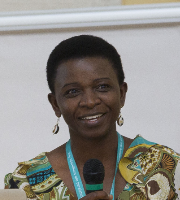The United Nations International Residual Mechanism for Criminal Tribunals (Mechanism) was established in December 2010 by the United Nations Security Council as the successor of the International Criminal Tribunal for Rwanda (ICTR) and the International Criminal Tribunal for the former Yugoslavia (ICTY). It began operations in Arusha in 2012 and in The Hague in 2013. According to its Statute, the Mechanism is mandated to, among other things, preserve and provide access to the archives of the ICTR, the ICTY, and the Mechanism itself. The Mechanism took custody of the ICTR and the ICTY archives by the time of the closure of these Tribunals in 2015 and 2017, respectively.
The volume and complexity of the material presents a variety of technical challenges, particularly with regard to the digital records. The ultimate volume of the digital archives will be approximately three petabytes, composed of born-digital and digitized documents, audio and video recordings, photographs, databases and websites - all of this in a variety of formats. To date, more than 50 file formats have been identified.
A good question, and part of responsible stewardship, is “What has the Mechanism done about this challenging task so far?” The short answer is “A lot” but only a few highlights will be mentioned here.
The Mechanism recognized that it was important to select and implement technologies that are fit for purpose. By January 2017, the Mechanism had acquired and implemented a purpose-built digital preservation system, including repository storage at both branches. The system is now fully operational and work to ingest the Tribunals’ records into the digital repository has begun. To date, more than 40,000 digital objects have been ingested. In addition, the Mechanism continues to digitize analogue records, particularly audiovisual recordings of courtroom hearings. All these activities are supported by a comprehensive set of policies, procedures and strategies, which continue to be developed.
The effort is not only justifiable, but warranted. The Mechanism is preserving for a broad range of stakeholders, including: the United Nations Security Council, which gave the mandate to preserve; the Mechanism itself, which uses the records to support its judicial and other functions; and external users, encompassing legal professionals, academic researchers, the media and the general public. In line with its mandate, the Mechanism aims to provide the widest possible access to the archives, while ensuring the continued protection of confidential information (see also the Mechanism’s access policy, available at: http://www.unmict.org/sites/default/files/documents/pd-mict-17-160812-en.pdf). Planning for access delivery is focusing on the needs of users (i.e. the Designated Community), the diversity of the audience, their characteristics and capabilities, and the tools necessary or available to access and interact with the material.
The Mechanism acknowledged in recent years that for success, it was important to be part of a community of like-minded professionals with whom it could collaborate in support of its mandate to ensure that the Tribunals’ digital archives in its custody remain trustworthy, accessible and useable in the future. To this end, in February 2017, it joined the Digital Preservation Coalition (DPC). It has already derived benefits from this membership. For instance, participating in the DPC’s “Connecting the Bits” and Strategy Day in June 2017 provided an opportunity to influence the DPC’s new strategic plan and steer it towards areas of interest to the Mechanism. A DPC briefing day in December 2017 on the concepts of “Significance and Authenticity” was ‘inspired’ by one notable challenge before the Mechanism: preserving evidence admitted in court proceedings. The Mechanism is a court, and this legal context confers specific requirements for the preservation of records that were used or may be used in legal proceedings. A fundamental preservation goal is to ensure that the authenticity that was ascribed by the court in admitting materials into evidence is maintained and preserved, and any preservation actions on these materials must not impact on their evidential value.
While financial constraints are an operational reality at the Mechanism, the United Nations has already invested a lot of resources in technologies, systems and specialist staff for preserving the Tribunals’ digital archives. Digital preservation is, however, a long-term endeavour. Active preservation activities are time-consuming and expensive but the Mechanism is well on its way.













































































































































